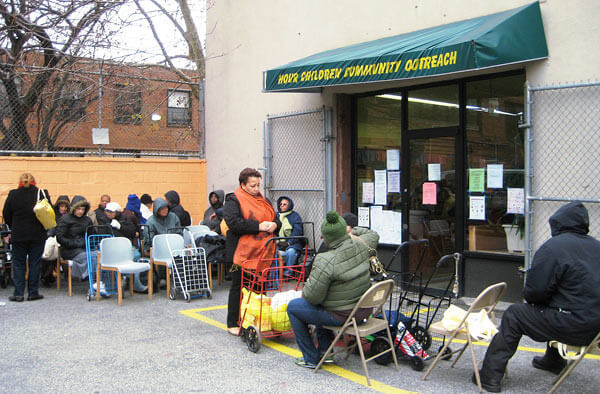By Philip Newman
More than 319,000 people in Queens live in households without enough food, although the borough trails the Bronx, which leads New York City in what a family advocacy agency calls “food insecurity.”
“The economic downturn and Superstorm Sandy ripped the bandages off the festering wounds of hunger and poverty in New York City,” said Joel Berg, executive director of the Coalition Against Hunger.
In the Bronx, the number of those short of food is 417,119, followed by Brooklyn at 251,960 and Manhattan at 227,506.
The survey does not include Staten Island, which the coalition said had a population too small to produce an accurate survey.
“Low-income people especially face a tidal wave of pain,” Berg said. “Now that the recession is officially over and the floodwaters have receded, we can easily see that New York is still suffering from a tale of two food cities. While the wealthy have better gourmet food than ever, one in six neighbors is struggling against hunger. The recent federal SNAP — Supplemental Nutrition Assistance Program, formerly food stamps — cuts will make all of this much worse.”
This year an average of 1.5 million people, including one in four children, lived in city households without adequate food. In the Bronx, which leads New York City in overall poverty, nearly half the children (48 percent) live in homes where there is not enough to eat.
“The release of this new data further underscores the critical need for nutrition programs like SNAP,” U.S. Rep. Joseph Crowley (D-Jackson Heights) said. “Millions of New Yorkers rely on it to put food on their tables and any cuts to the program would be devastating.”
In Queens, 43 percent of feeding agencies reported not having enough food to meet current demand, while 86 percent of responding agencies reported an increase in the number of people they served over the past year.
Otherwise in Queens:
• One in 10 of Queens residents lived in “food insecure” households totaling 319,764 in the period 2010-12.
• In 2006-08, 11.58 percent of Queens children had inadequate food.
• One in 13 of Queens seniors lived in food inadequate homes in 2010-12.
• In 2006-08, one in 15 Queens seniors had too little food.
• In 2010-12, more than 43 percent of soup kitchens and food pantries reported not having enough food to meet demand.
• 86 percent of agencies reported an increase in number of people served over the past year, with 72.7 percent of them families with children. They included large numbers of immigrants, seniors and the homeless.
• A total of 38.6 percent of the agencies reported a decrease in private funding for food in the past 12 months.
• 43.6 percent reported spending personal money on occasion to support feeding programs.
• 45.2 percent reported having to turn away the needy, reduce the amount of food to each person or curtail hours of operation because of a lack of money.
“It is crucial for programs like SNAP to remain strong,” said Abigael Burke, of Hour Children in Queens. “SNAP is our first line of defense supporting programs like Universal School Luncheon, and summer meals are crucial food pantries and soup kitchens are already strapped. We will be hard-pressed if faced with future cuts.”
State Sen. Jose Peralta (D-East Elmhurst) said “taking food off the plates of the needy to fatten the rich is not the American way.”
Reach contributing writer Philip Newman by e-mail at timesledgernews@cnglocal.com or phone at 718-260-4536.



































